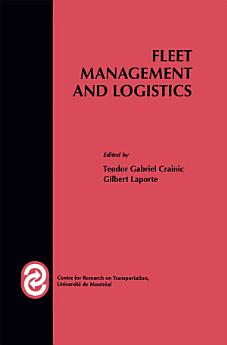Fleet Management and Logistics
Teodor G. Crainic · Gilbert Laporte
ডিচে ২০১২ · Springer Science & Business Media
৪.৩star
৩ টা পৰ্যালোচনাreport
ইবুক
252
পৃষ্ঠা
reportমূল্যাংকন আৰু পৰ্যালোচনা সত্যাপন কৰা হোৱা নাই অধিক জানক
এই ইবুকখনৰ বিষয়ে
TEODOR GABRIEL CRAINIC, DIRECTOR The Centre for Research on Transportation (C.R.T.) was founded in 1971 by the Universite de Montreal. From 1988 on, it is jointly managed by the Universite de Montreal and its affiliated schools, the Ecole des Hautes Etudes Commerciales and Ecole Poly technique. Professors, students and researchers from many institutions in the Montreal area join forces at the C.R.T. to analyze transportation, logistics and telecommunication systems from a multidisciplinary perspective. The C.R.T. pursues three major, complementary objectives: training of high-level specialists; the advancement of knowledge and technology; the transfer of technology towards industry and the public sector. Its main field of expertise is the develop ment of quantitative and computer-based models and methods for the analysis of urban, regional and intercity transportation networks, as well as telecommunication systems. This applies to the study of passenger and commodity flows, as well as to the socioeconomic aspects of transportation: policy, regulation, economics. The twenty-fifth anniversary of the C.R.T. offered the opportunity to evaluate past accomplishments and to identify future trends and challenges. Five colloquia were thus organized on major research and application themes that also reflected our main research areas. They gathered together internationally renowned researchers who linked recent scientific and technological advances to modeling and methodological challenges waiting to be tackled, particularly concerning new problems and applica tions, and the increasingly widespread use of new technologies.
মূল্যাংকন আৰু পৰ্যালোচনাসমূহ
৪.৩
৩ টা পৰ্যালোচনা
এই ইবুকখনক মূল্যাংকন কৰক
আমাক আপোনাৰ মতামত জনাওক।
পঢ়াৰ নির্দেশাৱলী
স্মাৰ্টফ’ন আৰু টেবলেট
Android আৰু iPad/iPhoneৰ বাবে Google Play Books এপটো ইনষ্টল কৰক। ই স্বয়ংক্রিয়ভাৱে আপোনাৰ একাউণ্টৰ সৈতে ছিংক হয় আৰু আপুনি য'তে নাথাকক ত'তেই কোনো অডিঅ'বুক অনলাইন বা অফলাইনত শুনিবলৈ সুবিধা দিয়ে।
লেপটপ আৰু কম্পিউটাৰ
আপুনি কম্পিউটাৰৰ ৱেব ব্রাউজাৰ ব্যৱহাৰ কৰি Google Playত কিনা অডিঅ'বুকসমূহ শুনিব পাৰে।
ই-ৰীডাৰ আৰু অন্য ডিভাইচ
Kobo eReadersৰ দৰে ই-চিয়াঁহীৰ ডিভাইচসমূহত পঢ়িবলৈ, আপুনি এটা ফাইল ডাউনল’ড কৰি সেইটো আপোনাৰ ডিভাইচলৈ স্থানান্তৰণ কৰিব লাগিব। সমৰ্থিত ই-ৰিডাৰলৈ ফাইলটো কেনেকৈ স্থানান্তৰ কৰিব জানিবলৈ সহায় কেন্দ্ৰত থকা সবিশেষ নিৰ্দেশাৱলী চাওক।






